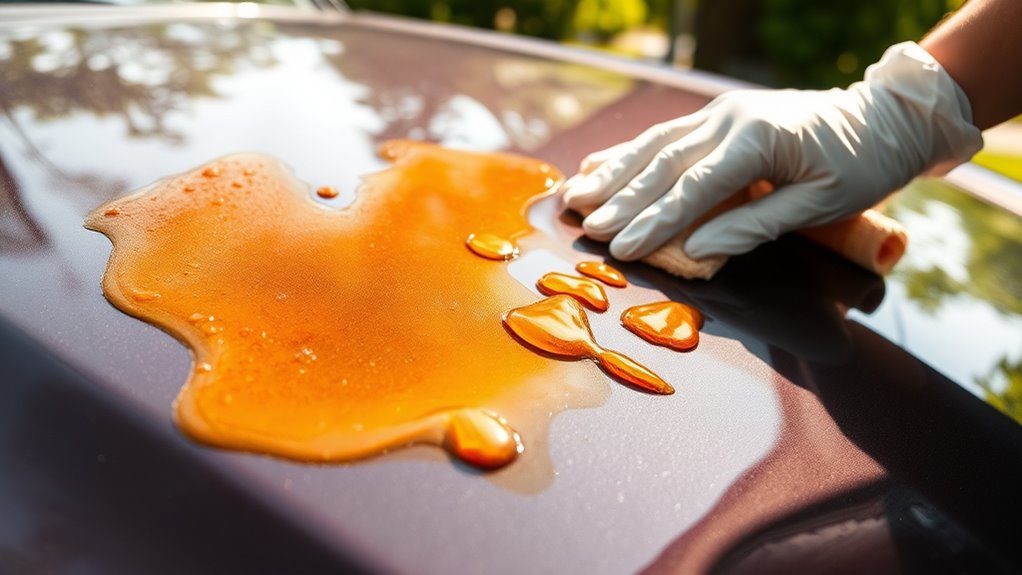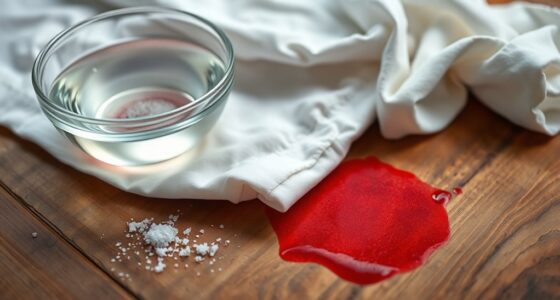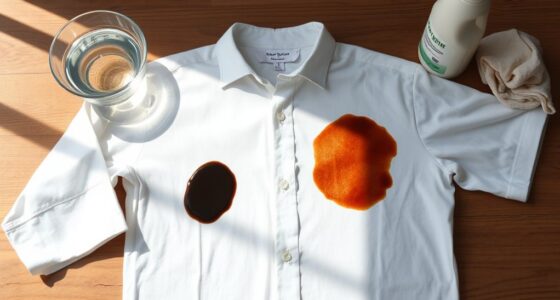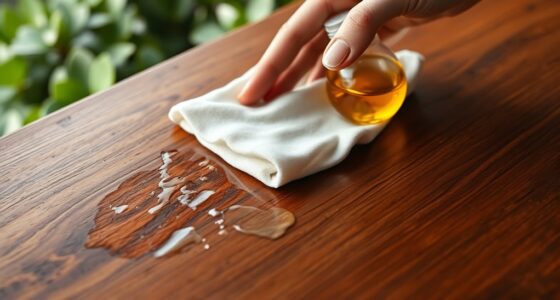To remove tree sap from your car’s exterior and windows, start by working in a shaded area. Use warm, soapy water or specialized products like Bug & Tar Remover. For tough spots, WD-40 or rubbing alcohol can help break it down. Always use a microfiber cloth to avoid scratches. After cleanup, consider waxing to protect your finish. If stubborn sap persists, you might want to explore more advanced removal techniques and preventative measures.
Key Takeaways
- Begin removal in shaded areas to prevent tree sap from hardening on surfaces.
- Use warm, soapy water or a specialized product like Sap Attack for effective cleaning.
- WD-40, hand sanitizer, or rubbing alcohol can help break down tougher sap residues.
- A plastic razor blade can be used gently to scrape off stubborn dried sap without damaging paint.
- Always finish by waxing the surface to protect against future sap and using glass cleaner for clear visibility.
Understanding Tree Sap and Its Impact on Cars
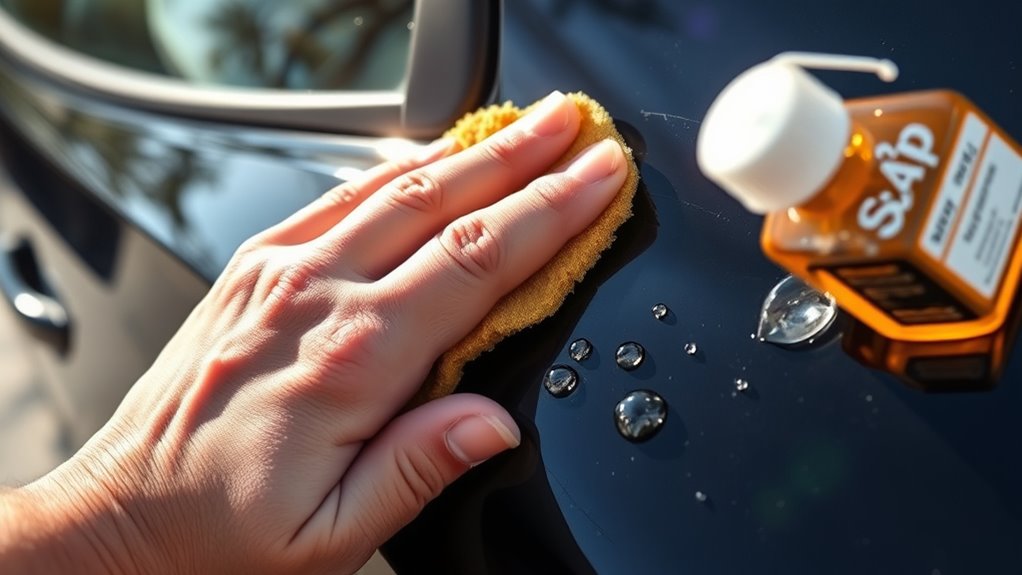
While enjoying a sunny day under your favorite tree, you mightn’t realize that tree sap can be a hidden menace for your car’s exterior. This sticky substance contains water, sugars, and minerals, making it particularly adhesive. As sap clings to your car, it can lead to unsightly spots and even discoloration. If left untreated, the resin in the sap can damage your paint, causing peeling over time. Each tree species produces sap with different compositions, meaning the impact on your car can vary. Environmental factors like temperature and humidity affect sap flow, so awareness is key. Transpiration creates a negative pressure gradient that pulls water and nutrients upwards, which contributes to the sap’s stickiness and adhesion. To protect your vehicle, consider parking away from trees and regularly waxing your car to create a barrier against sap adhesion.
Effective Methods for Removing Sap From Car Surfaces
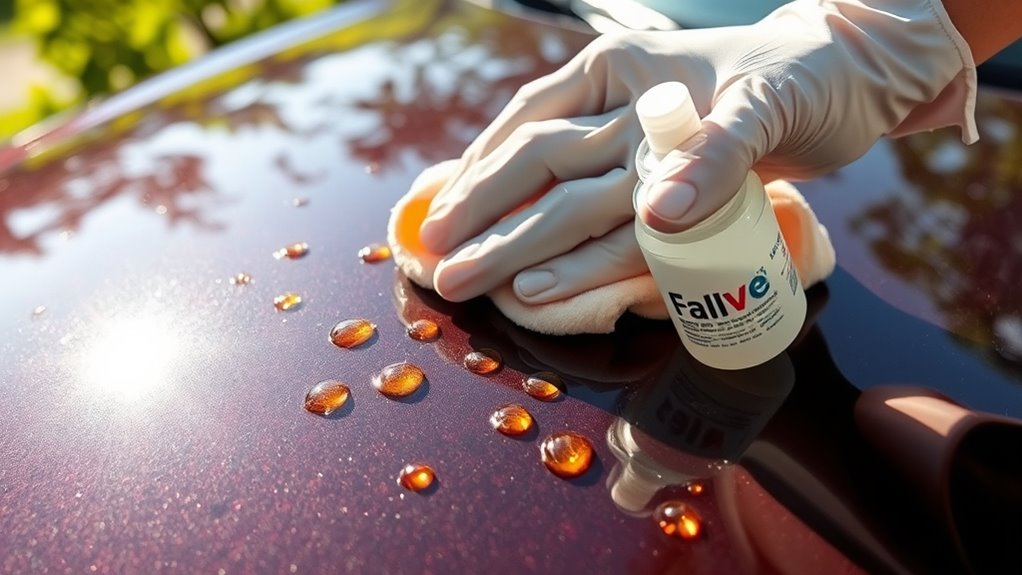
Removing tree sap from your car’s exterior can be a straightforward process if you use the right methods.
Start in a shaded area to prevent sap from hardening. Inspect and clean the surrounding area with soapy water before tackling the sap spots.
For gentle removal, mix warm water with mild car wash soap or use a waterless wash product. WD-40 and hand sanitizer can effectively break down sap as well. Hardened sap can lead to permanent damage if left untreated, so it’s crucial to address sap spots promptly.
For tougher spots, try a Bug & Tar Remover after washing. If sap remains embedded, a clay bar or specialized sap remover can help.
Always follow up with a wax or sealant to protect your car’s finish and regularly check for new sap to prevent damage.
Best Practices for Removing Sap From Car Windows
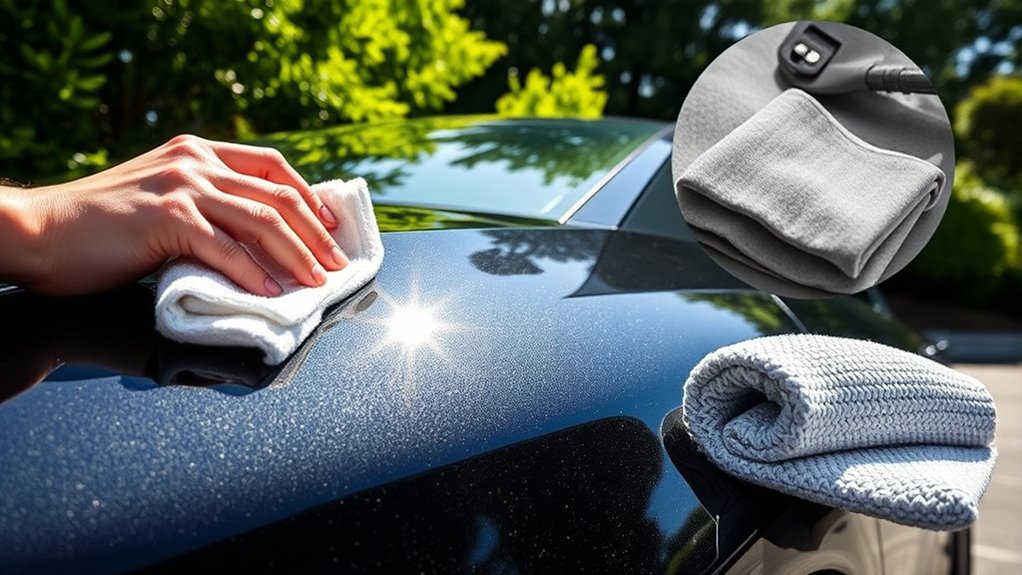
When you spot tree sap on your car windows, acting quickly can make the removal process much easier.
First, wear nitrile gloves and safety goggles to protect yourself. Check the sap’s freshness; if it’s fresh, a vinegar solution or rubbing alcohol can help loosen it. Using Sap Attack, a specialized product can make the removal process even more effective.
For stubborn spots, consider using a commercial sap remover or bug and tar remover. Always work in a shaded area to keep the sap pliable and avoid direct sunlight.
Use a microfiber cloth for cleaning, and if necessary, a plastic razor blade for scraping dried sap—just be gentle.
Afterward, finish with a glass cleaner to remove any residue and maintain a clear view. Regularly check for sap to prevent hardening.
Common Challenges and Solutions in Sap Removal
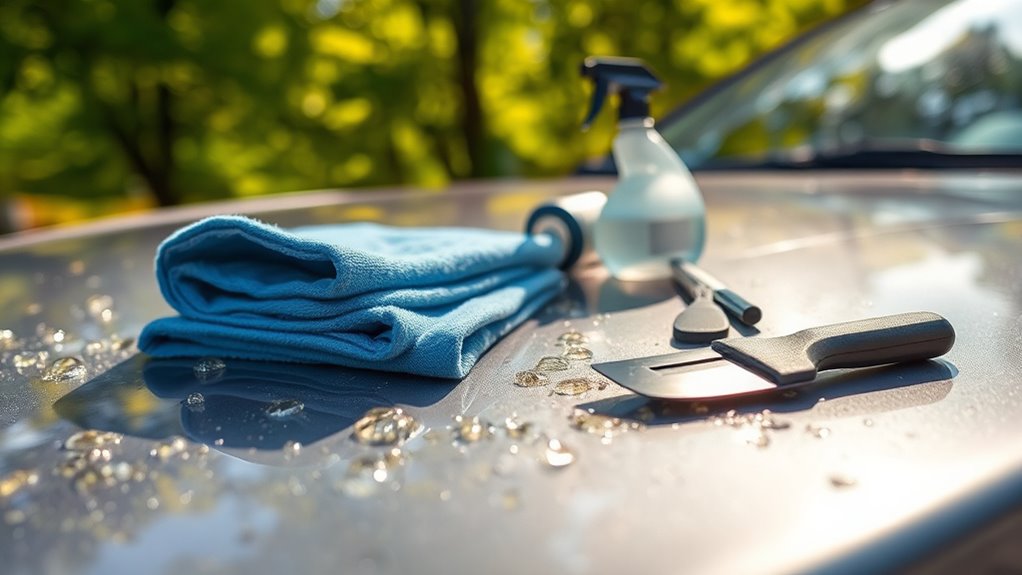
Tree sap can be a frustrating issue for car owners, especially when it hardens and becomes more difficult to remove. Sap from trees like pine, maple, and birch can quickly etch into your car’s paint if not addressed promptly. The best approach is to act fast; fresh sap can be wiped away with warm water and a microfiber towel. Always work in a shaded area to prevent hardening. For stubborn dried sap, consider using specialized products like Ex-Con or adhesive removers, but test them first. Knowledge of sap-producing trees can help you identify the source of the sap and take preventive measures. After removal, polishing your car will help restore its clarity. Regular inspections and avoiding parking under trees during sap peak seasons can help you stay ahead of this sticky problem.
Precautions and Safety Measures During Cleaning
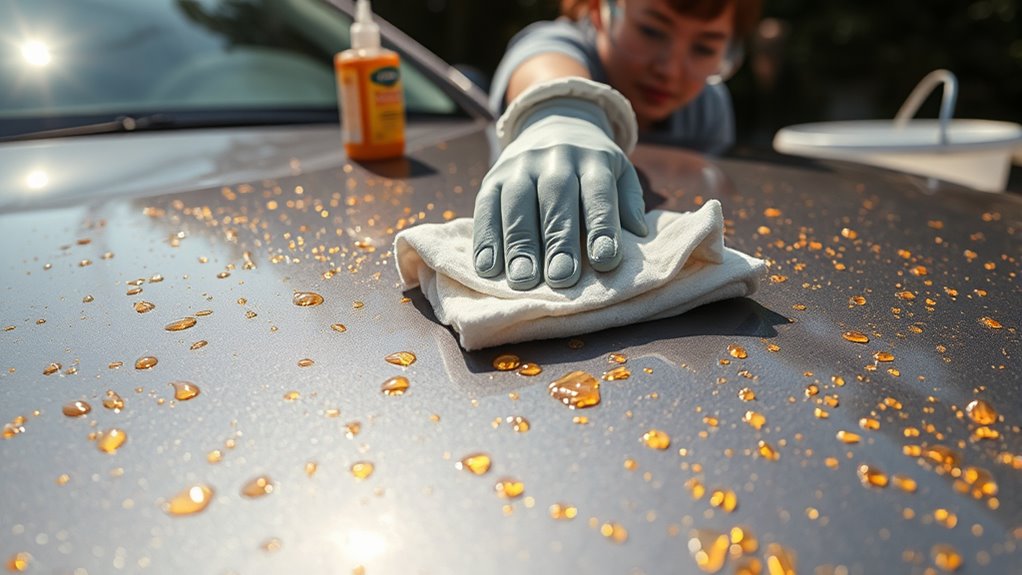
Before you start cleaning sap from your car, it’s essential to take some precautions to protect your vehicle’s paint and guarantee effective removal.
First, park your car in a shaded area to prevent the sap from hardening. Identify all the sap spots and use a mild car wash soap mixed with warm water to clean the affected areas.
Always use gentle, circular motions with a microfiber towel to avoid scratches. Test any cleaning product on an inconspicuous area first, and steer clear of harsh solvents like acetone. The longer sap remains on the surface, the more damage it can cause, so prompt action is crucial.
For stubborn sap, consider using isopropyl alcohol or specialized products.
Finally, once you’ve removed the sap, apply a protective wax to safeguard your car’s finish.
Preventive Measures to Avoid Sap Accumulation
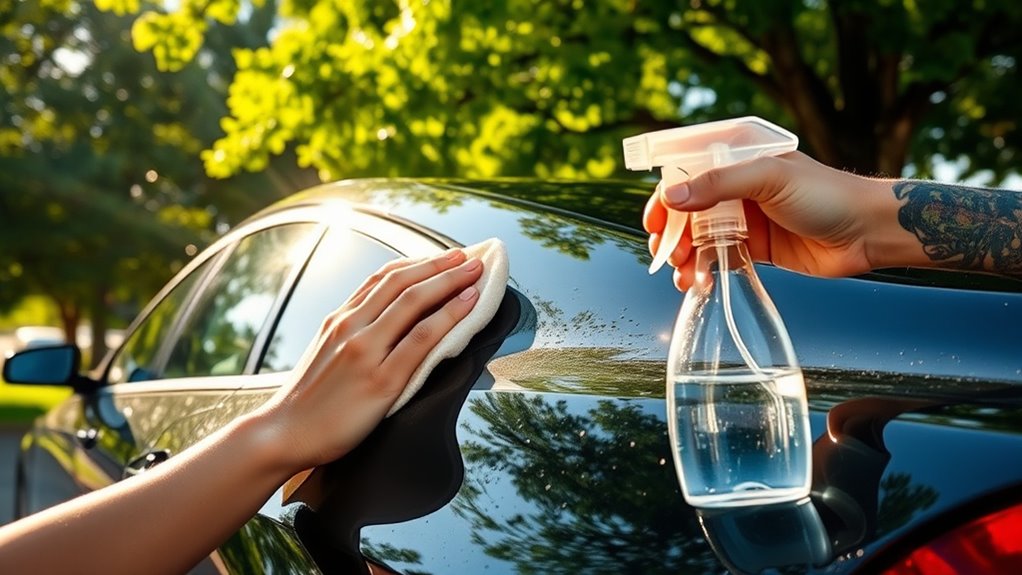
To keep sap from accumulating on your car, it’s crucial to be strategic about where you park. Avoid parking under trees that produce a lot of sap, like pine, maple, or oak.
If possible, opt for shaded lots or carports to reduce exposure. Be mindful of peak sap production seasons and steer clear of those trees during those times. Investing in a car cover can provide an extra layer of protection, especially if it fits well and is made of water-resistant material. Regular maintenance, such as timely cleaning and inspections, will help catch sap before it stains your paint. Additionally, consider applying a clear bra to create a durable barrier against sap damage. Understanding local tree species and collaborating with tree services can also minimize sap issues in your area.
Using Commercial Products for Sap Removal
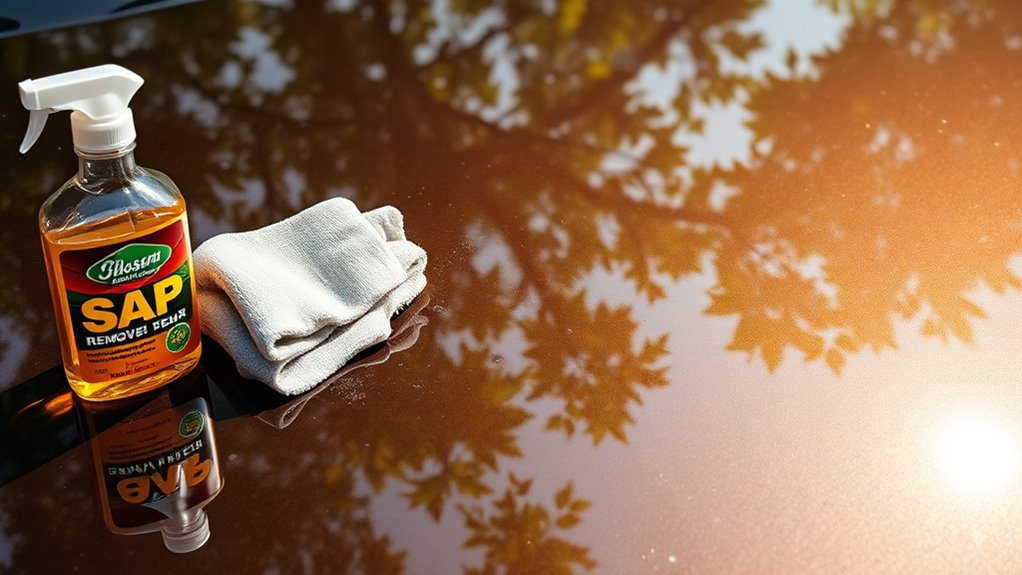
Commercial sap removers can be a game changer when tackling sticky sap spots on your car’s exterior. Designed to be safe for all car surfaces, these products effectively tackle tree sap, tar, and other contaminants without damaging your paint. Many use advanced solvents that penetrate stubborn residues, making removal easier. Professional strength solvent ensures that even the toughest stains can be addressed with minimal effort.
Applying them is straightforward; simply spray or use an applicator pad on the affected area. Allow the product to work for a few moments before gently wiping it away with a microfiber cloth. If needed, you can repeat the process until all sap is gone. With specialized options available, like pine tree sap removers, you’ll find the perfect solution to keep your car looking pristine.
Tips for Maintaining Your Car’s Exterior After Sap Removal
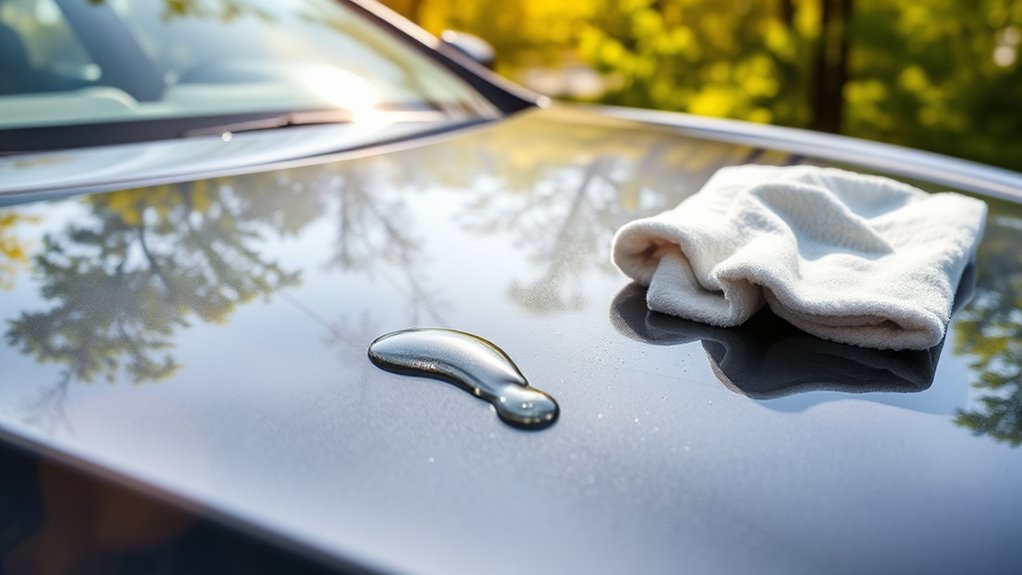
Once you’ve successfully removed tree sap from your car’s exterior, it’s essential to take steps to maintain your vehicle’s appearance and protect the paint.
Start by reapplying a quality wax or sealant to create a protective barrier. Regularly wash your car—preferably weekly—to eliminate contaminants before they set. Using a soft microfiber cloth to prevent scratches and avoid harsh chemicals that might damage the clear coat is crucial, especially since tree sap is sticky due to terpenes that can adhere more easily to unprotected surfaces. Consider applying a tree sap repellent spray to deter future adhesion.
Parking away from trees and using a car cover can further minimize sap exposure. Finally, schedule periodic detailing to address any deep-seated issues, ensuring your car remains in top condition for years to come.
When to Seek Professional Help for Sap Issues
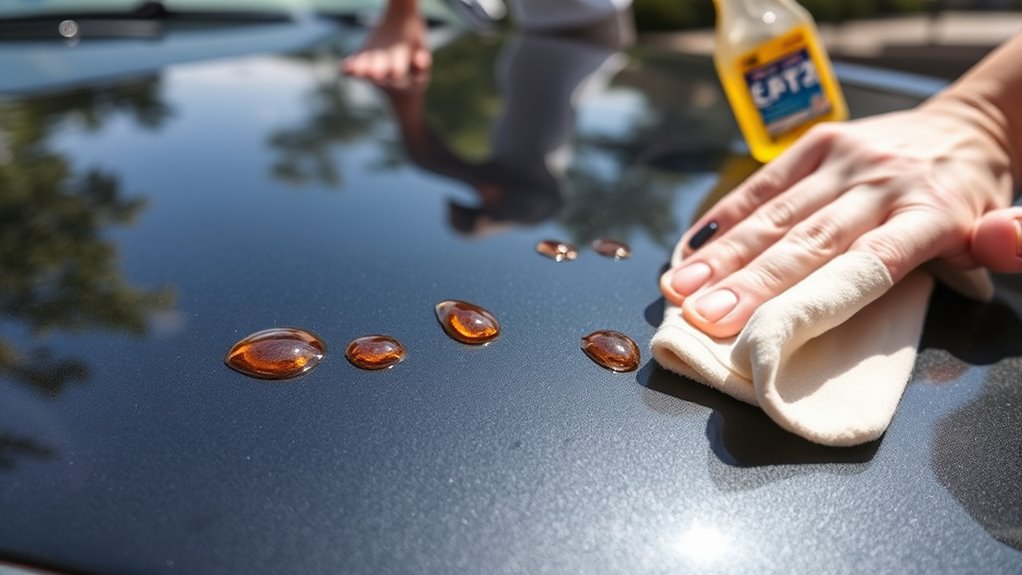
If you notice that tree sap stains on your car have become stubborn or widespread, it might be time to contemplate professional help. Signs like hardened sap or extensive coverage indicate that DIY methods may not be effective. If previous attempts have resulted in scratches or paint damage, seeking assistance is essential. Professionals use specialized equipment and techniques designed to avoid further harm while ensuring a thorough cleaning. Additionally, maintaining healthy trees can help reduce future sap issues, making it easier to keep your car clean. Consider local auto shops or mobile detailing services for expert intervention. Additionally, check your insurance policy—some may cover exterior damages like sap stains. Ultimately, investing in professional help can save you time, prevent further damage, and restore your car’s appearance effectively.
Frequently Asked Questions
Can Tree Sap Damage My Car’s Paint Permanently?
Yes, tree sap can permanently damage your car’s paint if you don’t address it quickly.
When sap hardens, it chemically bonds with the clear coat, leading to oxidation and fading over time. If UV rays bake it onto the surface, removing it becomes even tougher.
Regularly inspect your car and remove any sap you find to prevent long-term issues that might require professional help or repainting down the line.
How Can I Tell if Sap Is Fresh or Hardened?
You can tell if sap is fresh or hardened by examining its appearance and texture.
Fresh sap looks thin, watery, and often amber, while hardened sap appears darker and thicker.
Fresh sap’s sticky but soft consistency lets you wipe it away easily, whereas hardened sap feels rigid and tough to remove.
If you see droplets under trees in spring, it’s likely fresh; if it’s stuck and hard, it’s surely hardened.
Is There a Specific Time of Year for Sap Removal?
As spring blossoms awaken nature, sap flows like a river, making it the prime time for removal. You’ll find fresh sap easier to tackle now, but don’t let summer’s sun catch you off guard—hardened sap becomes a stubborn foe.
In fall, the vibrant foliage can hide pesky spots, while winter’s chill solidifies them further. So, keeping a seasonal routine in mind guarantees you’re ready to combat sap’s sticky challenges whenever they arise!
What Household Items Can I Use to Remove Sap?
When you’re dealing with stubborn sap, you can reach for several household items.
Cooking spray can loosen sap; just spray it on and scrub with a cloth. Vegetable oil works wonders too—apply it and wipe clean.
To tackle any residue, dish soap mixed with warm water is effective. Microfiber towels are great for wiping everything away without scratching surfaces.
Using these everyday items can make your sap removal process much easier and more efficient!
Can Tree Sap Affect My Car’s Resale Value?
Absolutely, tree sap can dramatically plummet your car’s resale value into the depths of despair!
If you let it linger, you’re inviting irreversible damage that etches your vehicle’s beauty away. Potential buyers see those imperfections and might envision a money pit instead of a gem.
By swiftly tackling sap stains, you not only preserve your car’s pristine appearance but also safeguard its market value.
Don’t let neglect cost you thousands when it’s so easily preventable!
Conclusion
To sum up, tackling tree sap doesn’t have to feel like an epic battle against nature! With the right techniques and a sprinkle of elbow grease, you can restore your car’s shine faster than a superhero can swoop in to save the day. Remember, prevention is key—so keep those sap-laden trees at bay! If all else fails, don’t hesitate to call in the pros. Your car deserves to sparkle like a diamond in the sun!
